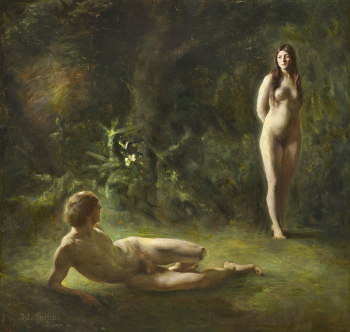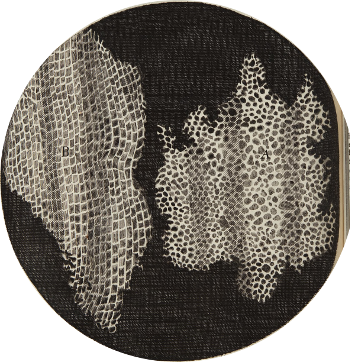Archaic Cells
June 4, 2018
Life on
Earth had its start in a simple
cellular organism known as the
Last Universal Common Ancestor (LUCA), which is thought to have existed about 3.5-3.8 billion years ago. It's estimated that the LUCA needed about 350
genes to function.
Experiments have produced
synthetic cells that function with just 473 genes.[1]
Since such a simple cell would have reproduced by
fission, the Last Universal Common Ancestor is both the
Adam and
Eve of all life on Earth. In 1859,
Charles Darwin wrote in his
On the Origin of Species that "... probably all the organic beings which have ever lived on this earth have descended from some one primordial form, into which life was first breathed."[2]

Adam and Eve, a painting by Julius Paulsen (1860-1940) created in 1893.
As part of a summer reading assignment in high school, I read The Social Contract by Jean-Jacques Rousseau (1712-1778).[3] This book contains the famous statement, "Man is born free; and everywhere he is in chains."
Rousseau is known for his idea of the noble savage, the wild state of humanity that preceded the strictures and corruptions of "civilization." This natural state of man is evident in this idyllic image of Adam and Eve.
(Wikimedia Commons image.)
Just as our
skin separates us from the rest of the world, cells have a
membrane that provides that function. The LUCA produced the first cell lineages of
bacteria and
archaea, and one distinguishing feature of these is the difference in the composition of their cell membranes. Bacterial membranes are composed of
glycerol-3-phosphate ester lipids, while the membranes of the archaea are composed of
glycerol-1-phosphate ether lipids,
straight-chain fatty acids that are
mirror images of each other. This brings to fore the question of how the LUCA could produce these different membrane types.
The accepted
hypothesis is that the LUCA had a cell membrane composed of both types of lipids. It was assumed that such a heterogeneous membrane would be less stable than one composed of just one type of
phospholipid, so there would have been a
lipid divide that produced the separate
domains of Bacteria and Archaea. Not unexpectedly, 3.5 billion year examples of the LUCA are lacking to test this hypothesis.

A 1665 drawing of cork cells from Micrographia by Robert Hooke (1635-1703), 1665.
Micrographia, which sold many copies, was the first book to contain microscope engravings of plants, insects, and manufactured objects.
It was the first book to use the word, "cell," to describe biological cells.
(From a copy at the National Library of Wales, via Wikimedia Commons)
To examine this hypothesis, a team of
Dutch scientists from the
University of Groningen (Groningen, The Netherlands), and
Wageningen University & Research (Wageningen, The Netherlands) genetically engineered a
microorganism with a mixed membrane. They found that this bacterium was stable, and it grew at a normal rate, thus dispelling the
lipid divide hypothesis. They report this
research in a
paper in the
Proceedings of the National Academy of Sciences.[4-5]
While
protocells might have formed in the hospitable
environment of
clay minerals, if they did start as simple lipid
vesicles of mixed lipids in which the phospholipids are mirror images of each other, a
lipid divide could have created the different Bacteria and Archaea domains.[5] To examine the stability of a cell having a mixed lipid membrane, the Dutch research team
genetically modified Escherichia coli to include the archaeal phospholipid in its membrane.[4] While this had been tried in previous
experiments, the resultant bacteria had only very small amounts (less than about 1%) of archaeal lipids.[5] The Dutch team boasted this to 30 percent, and the cells stably maintained the mixed heterochiral membrane[4-5]
Integration of the fully functional archaeal lipid pathway into the E. coli bacterium was accomplished by a combination of genetic modification to produce a means of the lipid production, and the use of a
statistically optimized medium.[4] The Dutch team discovered an
enzyme which is crucial to the production of archaeal membrane lipids, and this allowed creation of cells in which all
phosphatidylglycerol, which is about 30% of the bacterial membrane, was replaced by archaetidylglycerol, its archaeal equivalent. This genetically modified bacterium was stable, and it grew at a normal rate.[5]
The
robustness of these heterochiral membrane cells was found to be slightly better than that of unmodified E. coli.[4] Said
Arnold Driessen, an
author of the
paper and a
professor of
molecular microbiology at the University of Groningen,
"... we didn't know if the end result would be a viable cell... The robustness of these mixed cells surprised us. We expected more problems keeping them alive. After all, what we have engineered does amount to a new life form."[5]
The genetically engineered cells were more elongated than E. coli cells, and when the production of archaeal lipids was very high, their growth slowed with the membrane developing
lobular appendages that were eventually released from the cells (see photos).[4-5]

E. coli and mixed-membrane analog cells. From left to right, an electron microscope image of a normal E. coli cell, an engineered cell with a mixed membrane showing its elongated form, a normal dividing E. coli cell, and an engineered cell with high archaeal lipid production, showing lobular irregularities in the cell membrane. (First and second images, and third and fourth images, from the Van der Oost laboratory of the University of Wageningen.)
Archaeal cells are able to survive high
temperatures, and a higher temperature tolerance was observed in the modified E. coli cells.[4] The cells also had a higher tolerance to the
organic solvent l-butanol, so the presence of archaeal lipids seems to improve the fitness of the bacteria.[4] This finding might be useful in genetically engineering cells used in
industrial production applications to enable processes at higher temperature and in challenging environments.[4] This research was
funded by the
Origins Center, a Dutch national program that enables investigations of the
origin of life on Earth.[5]
References:
- Robert F. Service, "Synthetic microbe lives with fewer than 500 genes," Science, March 24, 2016, doi:10.1126/science.aaf9829.
- Charles Darwin, On the Origin of Species By Means of Natural Selection (London: John Murray, October 1, 1859), via Project Gutenberg.
- Jean-Jacques Rousseau, The Social Contract & Discourses, George Douglas Howard Cole, Trans., (New York, J. M. Dent & Sons, 1920), via Project Gutenberg.
- Antonella Caforio, Melvin F. Siliakus, Marten Exterkate, Samta Jain, Varsha R. Jumde, Ruben L. H. Andringa, Servé W. M. Kengen, Adriaan J. Minnaard, Arnold J. M. Driessen, and John van der Oost, "Converting Escherichia coli into an archaebacterium with a hybrid heterochiral membrane, Proceedings of the National Academy of Sciences, Article No. 1721604115, published ahead of print, March 19, 2018, https://doi.org/10.1073/pnas.1721604115. This is an open access article with a PDF file here
- 'New life form' answers question about evolution of cells, University of Groningen Press Release, March 15, 2018.
Linked Keywords: Life; Earth; cell; cellular; organism; Last Universal Common Ancestor (LUCA); gene; experiments; synthetic biology; fission (biology); Adam; Eve; Charles Darwin; On the Origin of Species; painting; Julius Paulsen (1860-1940); summer; reading; homework; assignment; high school; The Social Contract; Jean-Jacques Rousseau (1712-1778); Man is born free; and everywhere he is in chains; idea; noble savage; civilization; natural state of man; idyll; idyllic; Wikimedia Commons; skin; cell membrane; bacteria; archaea; glycerol-3-phosphate ester; lipid; glycerol-1-phosphate; ether lipid; open-chain compound; straight-chain; fatty acid; chirality; mirror image; hypothesis; phospholipid; domain (biology); Micrographia; Robert Hooke (1635-1703); microscope; engraving; plant; insect; manufacturing; manufactured object; biological cell; National Library of Wales; Dutch; scientist; University of Groningen (Groningen, The Netherlands); Wageningen University & Research (Wageningen, The Netherlands); genetic engineering; genetically engineered; microorganism; research; scientific literature; paper; Proceedings of the National Academy of Sciences of the United States of America; protocell; Graham Cairns-Smith clay hypothesis; environment; clay; mineral; vesicle; genetically modified; Escherichia coli; statistics; statistically; optimum; optimized; growth medium; enzyme; phosphatidylglycerol; resilience; robustness; Arnold Driessen; author; professor; molecular microbiology; lobe (anatomy); lobular appendage; scanning electron microscope; Van der Oost laboratory of the University of Wageningen; temperature; organic compound; solvent; l-butanol; industry; industrial; funding of science; funded; Origins Center; abiogenesis; origin of life on Earth.